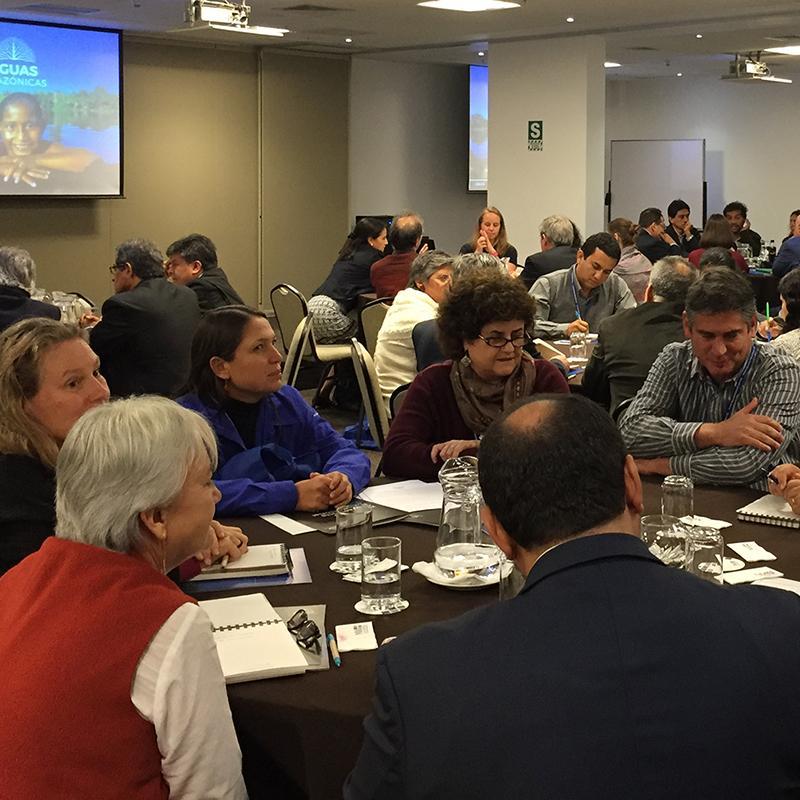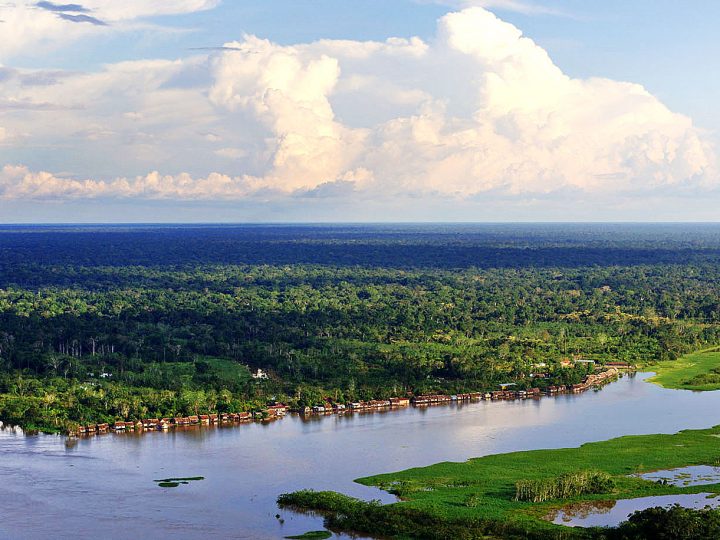
Immersing ourselves in the Amazon Basin: key speakers and concepts from the Amazon Waters International Conference, Day 2
Lima, Perú.- The second day of the Amazonian Waters International Conference, held on June 16 at the NM Lima Hotel and organized by the Wildlife Conservation Society (WCS), brought together specialists from the region with local authorities and stakeholders in conserving the Amazon basin. The first day culminated in the signing of the Joint Declaration on the Amazon Waters Initiative; the second day featured additional presentations as well as working groups, giving attendees variety in accessing and interacting with the information presented.
All presentations are available at http://amazonwaters.org; what follow are key concepts about the Amazon Basin by leading specialists at the conference.
Dr. Eduardo Venticinque, Professor at the Universidad Federal del Rio Grande del Norte in Brazil:
- “Approximately 80% of people in the Amazon live in Brazil, and most live near large rivers or wetlands. The problem we need to address is how to conserve wetlands and fisheries given considering how much migration and movement there is among fish.”
- “We must define the main stem of the Amazon in order to manage the Watersheds aren’t just hydrologic systems, they’re also ecological systems.”
- “In the Amazon, flood zones expand the area and make the tributaries smaller. This leads to small creeks being added to the main stem, when they really have behaviors more similar to flood plains.
- “For fisheries, we have defined the most important areas using different and sometimes contradictory criteria For many species, the habitats that are most important for their growth stages are off of the main stem.”
Dr. Carlos Cañas, Coordinator for the Amazon Waters Initiative at WCS Peru:
- “As in much of the Amazon, fishing in Loreto has not been well defined. Every resident is a potential fisherman; many families are linked to this activity. “
- “One of our major challenges is statistics. There are serious gaps in research, though it is important to have a database of where fish come from. So we started to document fishing at different scales, developing the concept in locations with high fish production. This has begun to involve more local authorities, improving our analytical capabilities at the local level.”
Dr. Manuel Glave, Principal Researcher at the Group for Analysis of Development and Professor at the Pontificia Universidad Católica del Perú:
- “It is important to quantify food security in the Amazon, and the role of fishing within it. And it is important how we approach food security in combination with issues such as the transformation of fish consumption as a major protein source.”
- “What we have is a shortage of information. We need to focus on strategic locations to search for data. “
Dr. Bruce Forsberg, aquatic ecologist at the National Institute of Amazonian Research in Brazil:
- “There are six major hydroelectric projects planned [in Brazil], and we have focused our research on the Pongo de Manseriche project, under the assumption that would have similar impacts as the other projects.”
- “This project is the biggest; it will affect areas both upstream and downstream from the dam, and the reservoir, due to the flooding of forests, will greenhouse gas emissions. Further, it will have a major impact on mercury exports and pollution, affecting the water and residents, and its impacts below the dam will be linked to sediment retention, changes in flood patterns, and landing—considering that four years after a flood there are usually and the fishing landing-considering that four years after a flood there are usually more fish in this area.”
Mino Sorribas, Researcher at the Hydrolic Research Institute at the Universidad Federal del Río Grande del Sur in Brazil:
- “The main question is how climate change might affect the hydrology of the Amazon. Therefore, there are three main elements to analyze: water balance, river flows, and flood dynamics. “
- “Using a large-scale model and calibrating it for the Amazon, we did a simulation of hydrology using future climate scenarios to generate our prediction. The results:
- Changes in rainfall
- Changes in evaporation/transpiration, which are highest in the southeast
- The average river flow increases in the west and decreases in the east.”
- “We need to evaluate the synergistic impact of dams and the hydrological model of climate change.”
Dra. Andrea Encalada, Principal Professor and Director of the Laboratory of Aquatic Ecology and and the Institute for Research, Management, and Restoration of Aquatic Ecosystems at the Universidad San Francisco de Quito in Ecuador:
- “In the Napo basin, the main questions focus on climate change and the vulnerability of aquatic ecosystems. We have carried out a tropical-temperate comparison: you can see that the range of physiological tolerance is lower in the tropics than in the temperate zone. “
- “With respect to ecological processes, we have five different elevations in which to analyze the decomposition processes in the altitudinal gradient. Thus we see the difference and change in what decomposes: microbes are important at higher altitudes, but there is a lower decomposition rate. These patterns are maintained in controlled systems, in particular in temperature control. “
Dra. Carolina Doria, Associate Professor at the Universidad Federal de Rondônia and Coordinator of the Ictiology and Fisheries Laboratory
- “The fishery system in the Madeira has very diverse actors, and there are conflicts between the different groups. These conflicts are increased when there is a dam. “
- “The government and construction companies have information available, but due to a history of corruption it can be difficult to access it.”
- “When we talk about dams, we know that it is important for the energy needs of the Amazon countries and that there has been a lot of money invested in these projects. The construction of dams has important socioeconomic effects, such as the displacement of people or access to resources.”
Edgardo Castro, Coordinator of the ProPachitea Program at the Institute for the Common Good and Associate Researcher at the Museum of Natural History in Peru:
- “There are various challenges for integrated watershed management in Peru. One of them is the mismatch between political and hydrological borders.”
Scalable framework for classifying basins – Eduardo Venticinque
Fisheries
Dr. Helder Queiroz – Instituto Mamirauá
Dr. Carlos Cañas – Wildlife Conservation Society
Dr. Manuel Glave – Grupo de Análisis para el Desarrollo
Infrastructure and climate change:
Dr. Bruce Forsberg – Instituto Nacional de Pesquisas da Amazonia
Mino Sorribas – Universidade Federal do Pio Grande do Sul
Dra. Andrea Encalada – Universidad San Francisco de Quito
Basin management and wetlands conservation:
Fabiano Silva – Fundação Vitória Amazônica



